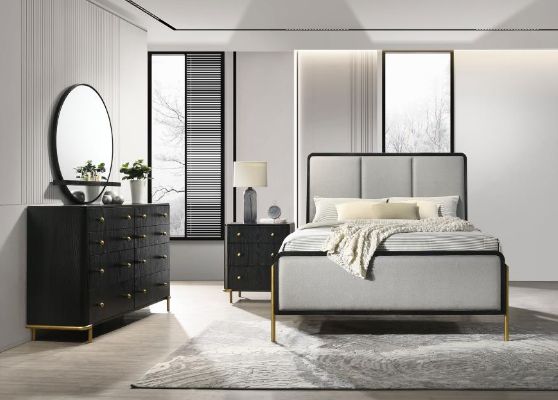All Categories
Featured
When making a living area, choosing the ideal furnishings style plays a vital role in establishing the tone and ambiance of the room. From timeless classics to modern-day innovations, there are various furniture designs offered to suit every aesthetic and choice. Below, we discover some of the most prominent furnishings styles for living room areas, aiding you make an informed decision to match your preference and lifestyle.
Typical furnishings shows style and sophistication, frequently influenced by 18th and 19th-century European layouts. Expect to find elaborate describing, rich timber finishes, and elegant materials like velour or brocade. Pieces such as tufted couches, wingback chairs, and intricately sculpted coffee tables are staples of this style. Typical furnishings produces a cozy and welcoming atmosphere, ideal for those who value ageless layout.
Modern furnishings stresses clean lines, simplicity, and capability. Commonly crafted from products like glass, steel, and wood, contemporary items have a streamlined and uncluttered look. Neutral shade schemes control this design, with pops of strong colors conserved. A minimal couch paired with a geometric coffee table is a perfect example of modern living space furniture.
While often puzzled with contemporary design, contemporary furniture is a lot more fluid and adapts to present patterns. This design mixes different components from numerous amount of time, resulting in an ever-evolving and functional visual. Contemporary living room furnishings commonly includes modular couches, mixed-material coffee tables, and statement illumination pieces that add personality to the area.
![]()
Promoted in the mid-20th century, this style is defined by its retro vibe and focus on performance. Secret attributes consist of conical legs, natural shapes, and a mix of synthetic and natural materials. Iconic mid-century modern furnishings items like the Eames easy chair or an inconspicuous sofa include a touch of nostalgia and elegance to any kind of living-room.
Inspired by city loft spaces and storage facilities, commercial furnishings integrates resources like metal, recovered wood, and concrete. This style commonly features exposed hardware, weathered finishes, and a neutral shade combination. Industrial-style living space furniture includes products like metal-framed coffee tables, natural leather couches, and open shelving devices that produce a tough yet stylish appearance.
Rustic furniture commemorates natural appeal and workmanship, often showcasing raw wood, stone, and earthy tones. This style brings the outdoors inside, developing a comfy and welcoming environment. Rustic living-room furniture may consist of reclaimed wood coffee tables, overstuffed sofas, and woven rugs that highlight convenience and simpleness.
For those who love carefree and diverse layout, bohemian furnishings offers a mix of patterns, shades, and appearances. This design encourages creativity and personalization, commonly including rattan chairs, formed cushions, and vintage or handmade pieces. A bohemian living-room is ideal for showcasing your originality.
Recognized for its minimalism and capability, Scandinavian furnishings combines form and practicality. With light timber tones, neutral colors, and simple designs, this style produces a calm and clutter-free setting. Typical components consist of comfy sofas, smooth coffee tables, and soft throws or cushions to enhance convenience.
![]()
Transitional furniture bridges the space between traditional and modern designs. It blends traditional style with modern simpleness, resulting in a harmonious and well balanced look. Neutral tones control this design, with clean-lined sofas and underrated coffee tables that function well in virtually any type of living room setup.
Despite your preference, there's a furnishings design to match your living room vision. Take some time to discover these alternatives, and don't think twice to mix and match styles to develop a space that's distinctively your own.
- Traditional Style
Typical furnishings shows style and sophistication, frequently influenced by 18th and 19th-century European layouts. Expect to find elaborate describing, rich timber finishes, and elegant materials like velour or brocade. Pieces such as tufted couches, wingback chairs, and intricately sculpted coffee tables are staples of this style. Typical furnishings produces a cozy and welcoming atmosphere, ideal for those who value ageless layout.
- Modern Design
Modern furnishings stresses clean lines, simplicity, and capability. Commonly crafted from products like glass, steel, and wood, contemporary items have a streamlined and uncluttered look. Neutral shade schemes control this design, with pops of strong colors conserved. A minimal couch paired with a geometric coffee table is a perfect example of modern living space furniture.
- Contemporary Style
While often puzzled with contemporary design, contemporary furniture is a lot more fluid and adapts to present patterns. This design mixes different components from numerous amount of time, resulting in an ever-evolving and functional visual. Contemporary living room furnishings commonly includes modular couches, mixed-material coffee tables, and statement illumination pieces that add personality to the area.
- Mid-Century Modern Design

Promoted in the mid-20th century, this style is defined by its retro vibe and focus on performance. Secret attributes consist of conical legs, natural shapes, and a mix of synthetic and natural materials. Iconic mid-century modern furnishings items like the Eames easy chair or an inconspicuous sofa include a touch of nostalgia and elegance to any kind of living-room.
- Industrial Style
Inspired by city loft spaces and storage facilities, commercial furnishings integrates resources like metal, recovered wood, and concrete. This style commonly features exposed hardware, weathered finishes, and a neutral shade combination. Industrial-style living space furniture includes products like metal-framed coffee tables, natural leather couches, and open shelving devices that produce a tough yet stylish appearance.
- Rustic Design
Rustic furniture commemorates natural appeal and workmanship, often showcasing raw wood, stone, and earthy tones. This style brings the outdoors inside, developing a comfy and welcoming environment. Rustic living-room furniture may consist of reclaimed wood coffee tables, overstuffed sofas, and woven rugs that highlight convenience and simpleness.
- Bohemian Style
For those who love carefree and diverse layout, bohemian furnishings offers a mix of patterns, shades, and appearances. This design encourages creativity and personalization, commonly including rattan chairs, formed cushions, and vintage or handmade pieces. A bohemian living-room is ideal for showcasing your originality.
- Scandinavian Design
Recognized for its minimalism and capability, Scandinavian furnishings combines form and practicality. With light timber tones, neutral colors, and simple designs, this style produces a calm and clutter-free setting. Typical components consist of comfy sofas, smooth coffee tables, and soft throws or cushions to enhance convenience.

- Transitional Design
Transitional furniture bridges the space between traditional and modern designs. It blends traditional style with modern simpleness, resulting in a harmonious and well balanced look. Neutral tones control this design, with clean-lined sofas and underrated coffee tables that function well in virtually any type of living room setup.
Despite your preference, there's a furnishings design to match your living room vision. Take some time to discover these alternatives, and don't think twice to mix and match styles to develop a space that's distinctively your own.
Latest Posts
Experience Coastal Style at Deauville Inn
Published Apr 18, 25
1 min read
A Historic Shoreline Destination with Modern Delights
Published Apr 15, 25
1 min read
A Historic Coastline Location with Modern Thrills
Published Apr 13, 25
1 min read